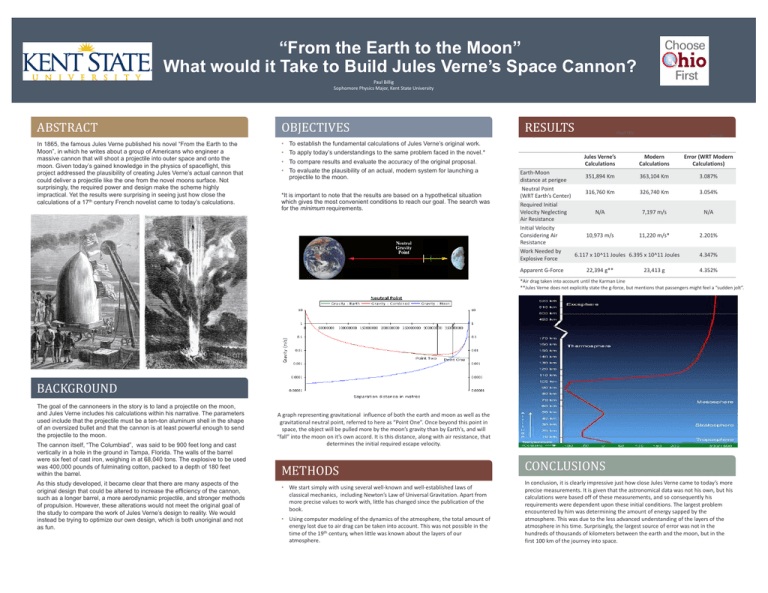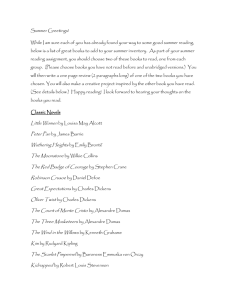Printing: “From the Earth to the Moon”
advertisement

“From the Earth to the Moon” What would it Take to Build Jules Verne’s Space Cannon? P Paul Billig Sophomore Physics Major, Kent State University OBJECTIVES In 1865, the famous Jules Verne published his novel “From the Earth to the Moon”, in which he writes about a group of Americans who engineer a massive cannon that will shoot a projectile into outer space and onto the moon. Given today’s gained knowledge in the physics of spaceflight, this project addressed the plausibility of creating Jules Verne’s actual cannon that could deliver a projectile like the one from the novel moons surface. Not surprisingly, the required power and design make the scheme highly impractical. Yet the results were surprising in seeing just how close the calculations of a 17th century French novelist came to today’s calculations. • To establish the fundamental calculations of Jules Verne’s original work. RESULTS Axis Titl ABSTRACT • To apply today’s understandings to the same problem faced in the novel.* Jules Verne’s Calculations • To compare results and evaluate the accuracy of the original proposal. • To evaluate the plausibility of an actual, modern system for launching a projectile to the moon. *It is important to note that the results are based on a hypothetical situation which gives the most convenient conditions to reach our goal. The search was for the minimum requirements. Chart Title Series 2, 1, 3, 2.8 4.5 5 10 0 Modern Calculations Earth-Moon 351,894 Km 363,104 Km distance at perigee Neutral Point 316,760 Km 326,740 Km (WRT Earth’s Center) Required Initial Velocity Neglecting N/A 7,197 m/s Air Resistance Initial Velocity Considering Air 10,973 m/s 11,220 m/s* Resistance Work Needed by 6.117 x 10^11 Joules 6.395 x 10^11 Joules Explosive Force Apparent G-Force 22,394 g** 23,413 g Error (WRT Modern Calculations) 3.087% 3.054% N/A 2.201% 4.347% 4.352% *Air drag taken into account until the Karman Line **Jules Verne does not explicitly state the g-force, but mentions that passengers might feel a “sudden jolt”. Th It la C Th fo p an Sm m T fr b If ti m d Sm w BACKGROUND The goal of the cannoneers in the story is to land a projectile on the moon, and Jules Verne includes his calculations within his narrative. The parameters used include that the projectile must be a ten-ton aluminum shell in the shape of an oversized bullet and that the cannon is at least powerful enough to send the projectile to the moon. The cannon itself, “The Columbiad”, was said to be 900 feet long and cast vertically in a hole in the ground in Tampa, Florida. The walls of the barrel were six feet of cast iron, weighing in at 68,040 tons. The explosive to be used was 400,000 pounds of fulminating cotton, packed to a depth of 180 feet within the barrel. As this study developed, it became clear that there are many aspects of the original design that could be altered to increase the efficiency of the cannon, such as a longer barrel, a more aerodynamic projectile, and stronger methods of propulsion. However, these alterations would not meet the original goal of the study to compare the work of Jules Verne’s design to reality. We would instead be trying to optimize our own design, which is both unoriginal and not as fun. A graph representing gravitational influence of both the earth and moon as well as the gravitational neutral point, referred to here as “Point One”. Once beyond this point in space, the object will be pulled more by the moon’s gravity than by Earth’s, and will “fall” into the moon on it’s own accord. It is this distance, along with air resistance, that determines the initial required escape velocity. METHODS • We start simply with using several well-known and well-established laws of classical mechanics, including Newton’s Law of Universal Gravitation. Apart from more precise values to work with, little has changed since the publication of the book. • Using computer modeling of the dynamics of the atmosphere, the total amount of energy lost due to air drag can be taken into account. This was not possible in the time of the 19th century, when little was known about the layers of our atmosphere. CONCLUSIONS In conclusion, it is clearly impressive just how close Jules Verne came to today’s more precise measurements. It is given that the astronomical data was not his own, but his calculations were based off of these measurements, and so consequently his requirements were dependent upon these initial conditions. The largest problem encountered by him was determining the amount of energy sapped by the atmosphere. This was due to the less advanced understanding of the layers of the atmosphere in his time. Surprisingly, the largest source of error was not in the hundreds of thousands of kilometers between the earth and the moon, but in the first 100 km of the journey into space. W in ri C p b




